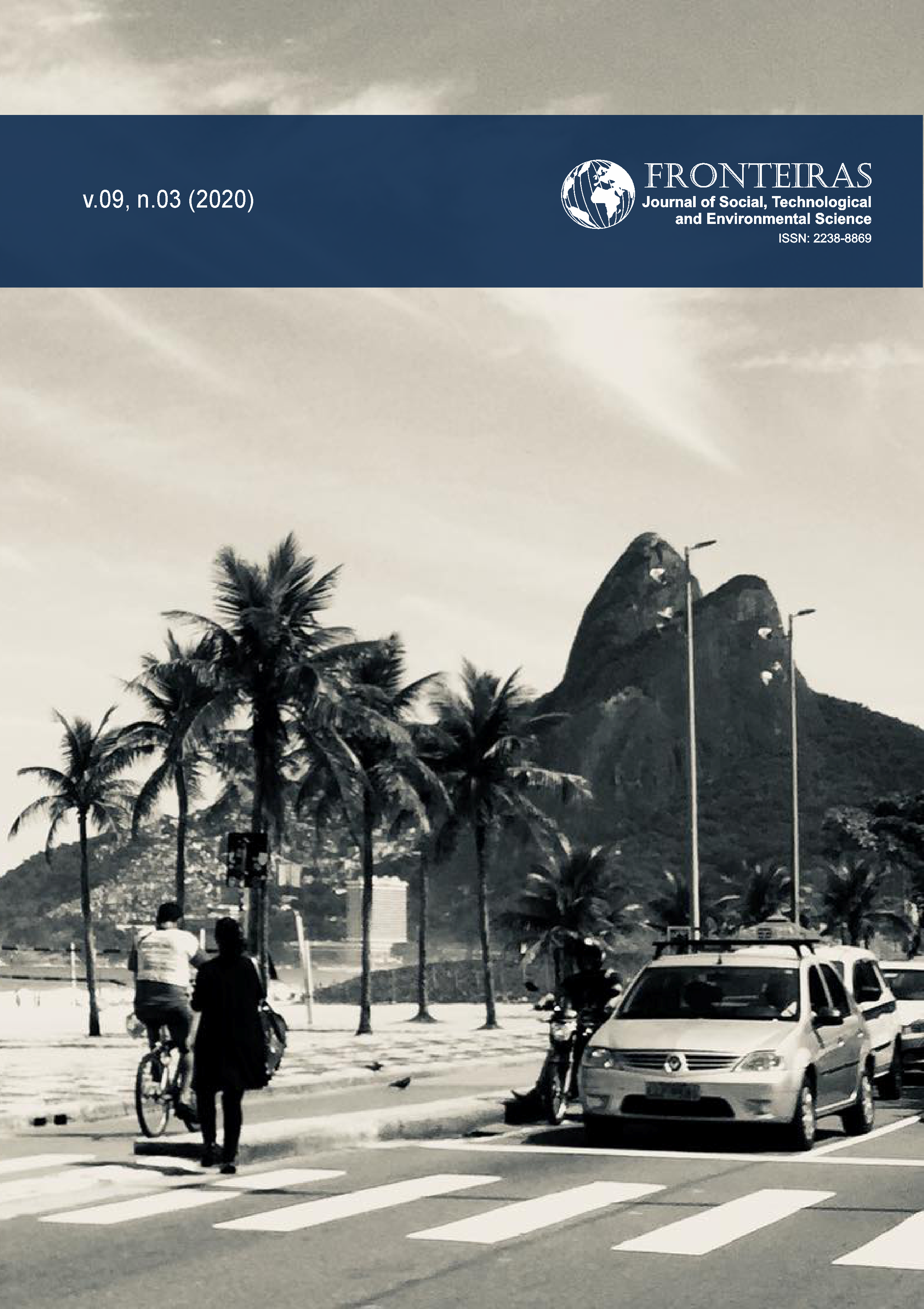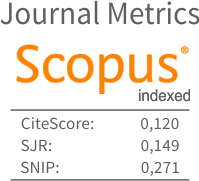Comparison of the Regional and Global Production of Scientific Papers: A Perspective from Freshwater Fish Studies in Goiás State, Central Brazil
DOI:
https://doi.org/10.21664/2238-8869.2020v9i3.p55-66Palabras clave:
Paraná Basin, Tocantins-Araguaia Basin, Temporal Trends, Financial SupportResumen
Scientific production is often explored at broader scales but understanding whether regional trends follow global ones is an important issue for science and public policies. Using freshwater fish papers’ production in the Goiás State, Central Brazil, we tested two hypotheses: i) regional production of papers follows global tendencies; ii) regional production is driven by the number of authors, institutions, financial support and dissertations/thesis produced. From published papers we extracted the: year of publication, authors’ institution, journal of publication, impact factor and financial support. To test both hypotheses we performed, respectively, a Pearson correlation between papers number and year, and a multiple linear regression considering papers number or impact factor as response variable and authors, institutions, financial support and dissertations/thesis as predictors variables. We observed a positive correlation between papers number and year, whereas financial support, institutions and dissertation/thesis were the main drivers for papers number and impact factor. Regional production of fish papers follows global patterns of production (financial support and institutions number as mains drivers). However, this production remains influenced by particularities such as: an inconstant production through time and the fact that many papers are still published in journals without an impact factor.
Citas
Almeida, Elenara Chaves Edler de, and Jorge Almeida Guimarães. 2013. “Brazil’s Growing Production of Scientific Articles—How Are We Doing with Review Articles and Other Qualitative Indicators?” Scientometrics 97 (2): 287–315. https://doi.org/10.1007/s11192-013-0967-y.
Braudes-Araújo, Nicelly, Francisco Leonardo Tejerina-Garro, and Rodrigo Assis de Carvalho. 2019. “Biodiversidade de Peixes Na Bacia Hidrográfica Tocantins-Araguaia, Brasil.” In Tópicos Em Conservação e Manejo Do Cerrado: Biodiversidade, Solos e Uso Sustentável, edited by Sabrina do Couto de Miranda, Plauto Simão De-Carvalho, and Adriana Aparecida Ribon, 109–66. Goiânia: Editora Kelps.
Carneiro, Fernanda Melo, João Carlos Nabout, and Luis Mauricio Bini. 2008. “Trends in the Scientific Literature on Phytoplankton.” Limnology 9 (2): 153–58. https://doi.org/10.1007/s10201-008-0242-8.
Carvalho, Rodrigo Assis, and Francisco Leonardo Tejerina-Garro. 2019. “Spatial and Temporal Trends in Freshwater Fish Research: The Case of Three Neotropical River Basins from Goiás State, Central Brazil.” Acta Limnologica Brasiliensia 31. https://doi.org/10.1590/s2179-975x5418.
Castro, Ricardo M. C. 1999. “Evolução Da Ictiofauna de Riachos Sul-Americanos: Padrões Gerais e Possíveis Processos Causais.” In Ecologia de Peixes de Riachos: Estado Atual e Perspectivas, edited by E. P. Caramaschi, R. Mazzoni, C. R. S. F. Bizerril, and P. R. Peres-Neto, 139–55. Rio de Janeiro: PPGE-UFRJ.
Delgado-López-Cózar, Emilio, and Rafael Repiso-Caballero. 2013. “The Impact of Scientific Journals of Communication: Comparing Google Scholar Metrics, Web of Science and Scopus.” Comunicar 21 (41): 45–52. https://doi.org/10.3916/C41-2013-04.
Dias, Murilo S., Jansen Zuanon, Thiago B.A. Couto, Marla Carvalho, Lucélia N. Carvalho, Helder M.V. Espírito-Santo, Renata Frederico, et al. 2016. “Trends in Studies of Brazilian Stream Fish Assemblages.” Natureza & Conservação 14 (2): 106–11. https://doi.org/10.1016/j.ncon.2016.06.003.
Fernandes, Gustavo Andrey Almeida Lopes, and Leonardo de Oliveira Manchini. 2019. “How QUALIS CAPES Influences Brazilian Academic Production? A Stimulus or a Barrier for Advancement?” Brazilian Journal of Political Economy 39 (2): 285–305. https://doi.org/10.1590/0101-31572019-3006.
Fischer, Joern, Euan G. Ritchie, and Jan Hanspach. 2012. “Academia’s Obsession with Quantity.” Trends in Ecology & Evolution 27 (9): 473–74. https://doi.org/10.1016/j.tree.2012.05.010.
Ghani, Intan Martina Md, and Sabri Ahmad. 2010. “Stepwise Multiple Regression Method to Forecast Fish Landing.” Procedia - Social and Behavioral Sciences 8: 549–54. https://doi.org/10.1016/j.sbspro.2010.12.076.
Glänzel, Wolfgang, Jacqueline Leta, and Bart Thijs. 2006. “Science in Brazil. Part 1: A Macro-Level Comparative Study.” Scientometrics 67 (1): 67–86. https://doi.org/10.1007/s11192-006-0055-7.
Harzing, Anne-Wil, and Satu Alakangas. 2016. “Google Scholar, Scopus and the Web of Science: A Longitudinal and Cross-Disciplinary Comparison.” Scientometrics 106 (2): 787–804. https://doi.org/10.1007/s11192-015-1798-9.
Huang, Ding-wei. 2015. “Temporal Evolution of Multi-Author Papers in Basic Sciences from 1960 to 2010.” Scientometrics 105 (3): 2137–47. https://doi.org/10.1007/s11192-015-1760-x.
King, David A. 2004. “The Scientific Impact of Nations.” Nature 430 (6997): 311–16. https://doi.org/10.1038/430311a.
Loyola, Rafael D., José Alexandre F. Diniz-Filho, and Luis Mauricio Bini. 2012. “Obsession with Quantity: A View from the South.” Trends in Ecology & Evolution 27 (11): 585. https://doi.org/10.1016/j.tree.2012.07.016.
Marenco, André. 2015. “When Institutions Matter: CAPES and Political Science in Brazil.” Revista de Ciência Política 35 (1): 33–46.
Meis, Leopoldo de, Ana Paula Arruda, and Jorge Guimarães. 2007. “The Impact of Science in Brazil.” IUBMB Life 59 (4): 227–34. https://doi.org/10.1080/15216540701258140.
Mena-Chalco, Jesús Pascual, Luciano Antonio Digiampietri, Fabrício Martins Lopes, and Roberto Marcondes Cesar. 2014. “Brazilian Bibliometric Coauthorship Networks.” Journal of the Association for Information Science and Technology 65 (7): 1424–45. https://doi.org/10.1002/asi.23010.
Nabout, João Carlos, Priscilla Carvalho, Marcio Uehara Prado, Pedro Paulino Borges, Karine Borges Machado, Kátia Bittar Haddad, Thaísa Sala Michelan, Hélida Ferreira Cunha, and Thannya Nascimento Soares. 2012. “Trends and Biases in Global Climate Change Literature.” Natureza & Conservação 10 (1): 45–51. https://doi.org/10.4322/natcon.2012.008.
Nabout, João Carlos, Micael Rosa Parreira, Fabrício Barreto Teresa, Fernanda Melo Carneiro, Hélida Ferreira da Cunha, Luciana de Souza Ondei, Samantha Salomão Caramori, and Thannya Nascimento Soares. 2015. “Publish (in a Group) or Perish (Alone): The Trend from Single- to Multi-Authorship in Biological Papers.” Scientometrics 102 (1): 357–64. https://doi.org/10.1007/s11192-014-1385-5.
Nakazawa, Minato. 2018. “Fmsb: Functions for Medical Statistics Book with Some Demographic Data.” Cran.r-Project.Org. 2018. https://cran.r-project.org/web/packages/fmsb/index.html.
Oksanen, Jari, F. Guillaume Blanchet, Michael Friendly, Roeland Kindt, Pierre Legendre, Dan McGlinn, Peter R. Minchin, et al. 2018. “Vegan: Community Ecology Package.” Cran.r-Project.Org. 2018. https://cran.r-project.org/package=vegan.
Padial, André Andrian, João Carlos Nabout, Tadeu Siqueira, Luis Mauricio Bini, and José Alexandre Felizola Diniz-Filho. 2010. “Weak Evidence for Determinants of Citation Frequency in Ecological Articles.” Scientometrics 85 (1): 1–12. https://doi.org/10.1007/s11192-010-0231-7.
Pan, Raj Kumar, Kimmo Kaski, and Santo Fortunato. 2012. “World Citation and Collaboration Networks: Uncovering the Role of Geography in Science.” Scientific Reports 2 (1): 902. https://doi.org/10.1038/srep00902.
Parreira, Micael Rosa, Karine Borges Machado, Ramiro Logares, José Alexandre Felizola Diniz-Filho, and João Carlos Nabout. 2017. “The Roles of Geographic Distance and Socioeconomic Factors on International Collaboration among Ecologists.” Scientometrics 113 (3): 1539–50. https://doi.org/10.1007/s11192-017-2502-z.
Rigby, John. 2013. “Looking for the Impact of Peer Review: Does Count of Funding Acknowledgements Really Predict Research Impact?” Scientometrics 94 (1): 57–73. https://doi.org/10.1007/s11192-012-0779-5.
Roos, Daniel Henrique, Luciana Calabró, Sandra Lopes de Jesus, Diogo Onofre Souza, Nilda Vargas Barbosa, and João Batista Teixeira da Rocha. 2014. “Brazilian Scientific Production in Areas of Biological Sciences: A Comparative Study on the Modalities of Full Doctorate in Brazil or Abroad.” Scientometrics 98 (1): 415–27. https://doi.org/10.1007/s11192-013-1017-5.
Scijournal.org. 2018. “Impact Factor Lists.” Scijournal.Org. International Scientific Institute. 2018. https://www.scijournal.org/index.html.
Souza, Cristina Gomes de, and Marta Lúcia Azevedo Ferreira. 2013. “Researchers Profile, Co-Authorship Pattern and Knowledge Organization in Information Science in Brazil.” Scientometrics 95 (2): 673–87. https://doi.org/10.1007/s11192-012-0882-7.
Tejerina-Garro, Francisco Leonardo. 2008. “Biodiversidade e Impactos Ambientais No Estado de Goiás.” In Cerrado, Sociedade e Ambiente: Desenvolvimento Sustentável Em Goiás, edited by Cleonice Rocha, Francisco Leonardo Tejerina-Garro, and José Paulo Pietrafesa, 15–47. Goiânia: Editora da UCG.
Tejerina-Garro, Francisco Leonardo, Rodrigo Assis de Carvalho, and Fabrício Barreto Teresa. 2017. “A Biodiversidade e a Conservação Da Ictiofauna Do Alto Da Bacia Do Rio Paraná No Estado de Goiás, Brasil Central.” In Biodiversidade, Manejo e Conservação Do Sul de Goiás, edited by Wellington Hannibal, Reile Ferreira Rossi, Isa Lucia de Morais, and Laura Helena Marcon Teixeira, 93–126. Jundiaí, SP: Paco Editorial.
The R Development Core Team. 2018. “The R Project for Statistical Computing.” R-Project.Org. The R Foundation. 2018. https://www.r-project.org/.
Vasconcelos, Sonia M. R., Martha M. Sorenson, and Jacqueline Leta. 2009. “A New Input Indicator for the Assessment of Science & Technology Research?” Scientometrics 80 (1): 217–30. https://doi.org/10.1007/s11192-008-2082-z.
Vermeulen, Niki, John N. Parker, and Bart Penders. 2013. “Understanding Life Together: A Brief History of Collaboration in Biology.” Endeavour 37 (3): 162–71. https://doi.org/10.1016/j.endeavour.2013.03.001.
Whitfield, John. 2008. “Collaboration: Group Theory.” Nature 455 (7214): 720–23. https://doi.org/10.1038/455720a.
Woolnough, D. A., J. A. Downing, and T. J. Newton. 2009. “Fish Movement and Habitat Use Depends on Water Body Size and Shape.” Ecology of Freshwater Fish 18 (1): 83–91. https://doi.org/10.1111/j.1600-0633.2008.00326.x.
Descargas
Publicado
Cómo citar
Número
Sección
Licencia
Esta revista oferece acesso livre imediato ao seu conteúdo, seguindo o princípio de que disponibilizar gratuitamente o conhecimento científico ao público proporciona maior democratização mundial do conhecimento.
A partir da publicação realizada na revista os autores possuem copyright e direitos de publicação de seus artigos sem restrições.
A Revista Fronteiras: Journal of Social, Technological and Environmental Science segue os preceitos legais da licença Creative Commons - Atribuição-NãoComercial 4.0 Internacional.


